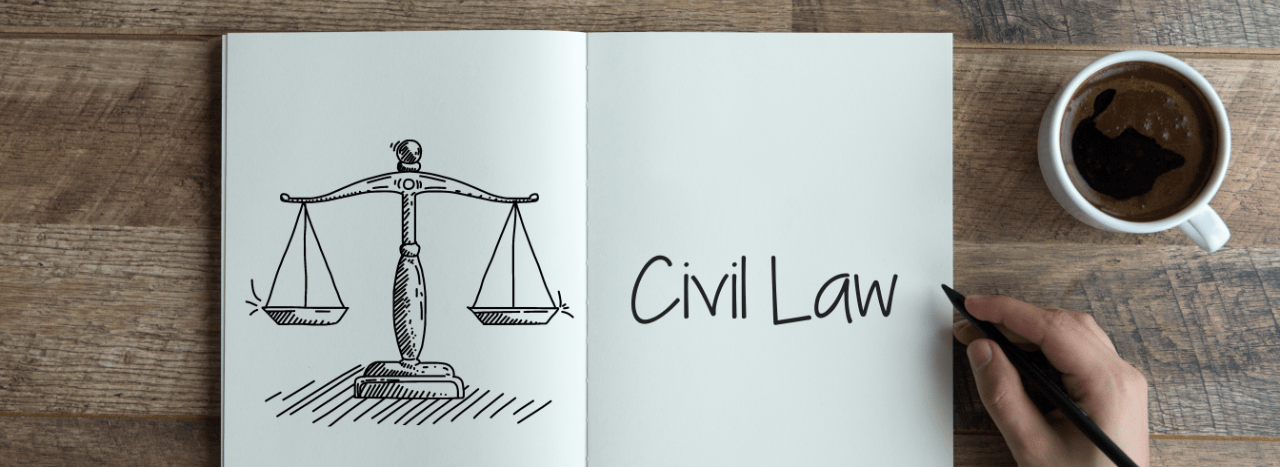The anatomy of a civil lawsuit
Every case does not end up in a civil lawsuit; many disputes with attorney involvement are settled pre-suit. But sometimes, it’s necessary.
A civil lawsuit allows companies and citizens a reasonably organized manner in which to resolve disputes and restore justice for wrongs, through monetary awards. This is much different than a criminal prosecution case, where the state or federal prosecutors seek criminal fines or convictions for violations of criminal laws.
State vs. Federal Civil Lawsuits
In state and federal court, there are Rules of Civil Procedure that govern virtually every aspect of a lawsuit to some extent. The federal and state Rules of Civil Procedure are fairly uniform. Local rules in various U.S. District Courts (federal) and individual counties in state courts slightly modify procedures; but for the most part, most suits are comprised of same basic documents and activities.
The “Pleadings” of a Civil Case
A lawsuit begins when one person or company (Plaintiff), prepares and files a document in a court having jurisdiction over the parties (personal jurisdiction) and the subject matter (subject matter jurisdiction), alleging some kind of wrongdoing by another person or company (Defendant).
Summons and Complaint
This first pleading is called a Complaint. Attached to that Complaint is the Summons, advising the party being served how many days there are to file an Answer to the allegations in the Complaint.
Answer/Counterclaims/Cross-claims
After being served with the Summons and Complaint, the Defendant is allowed 30 days respond to the factual allegations of the Complaint (Defendant’s Answer). The Defendant may also file a Counterclaim against the Plaintiff for damages the Defendant says he suffered due to an alleged wrongdoing of the Plaintiff, arising out of the same transaction or occurrence that gave rise to the original suit. The Counterclaim is filed as part of the Defendant’s Answer generally, but not always; so the document is usually entitled: Defendant’s Answer and Counterclaim. When more than one Defendant is being sued by one or more Plaintiffs, and one Defendant files a claim against a co-Defendant, that is called a Cross-Claim. The responses to counterclaims and cross-claims are respectively entitled Reply to Counterclaim, or Reply to Cross-Claim.
Default
If a Party who is required to file and Answer to a complaint or reply to a counterclaim or cross-claim, fails to do so, the other party may make a Motion for Default; and if the court holds a person or company in default for failing to answer or reply, the allegations in the complaint, counterclaim or cross-claim, are judicially deemed admitted to by that party. There are certain instances of “excusable neglect” that allow a party to be relieved of a finding of Default. Courts typically prefer to try cases on the merits, rather than judicially ordering findings of fact based on someone missing a deadline, especially if the party failed to timely file an Answer for a good reason.
If the court holds a party in Default, then an Order of Default is issued; and many times, the only issue remaining is damages, at which time a damages hearing can be set for a judge or jury. If the court excuses a party from Default, the case simply gets litigated and tried on the merits of the case, with all questions of fact still determined by a judge or a jury.
Discovery
Discovery is a process of obtaining information and documents related to the claims and defenses involved in the civil suit. The South Carolina Rules of Civil Procedure (SCRCP) allow parties to discover information, documents and things that are “reasonably calculated to lead to the discovery of admissible evidence.” SCRCP 26. This is a fairly broad net of information. For example, in an auto accident case, if the Plaintiff is claiming mental anguish and depression from the accident, the insurance company lawyer can ask for the names of all psychiatrists or other mental health counselors the Plaintiff has gone to in the last 10 years prior to the auto accident; and then subpoena those records. The argument is that there may have been other problems in the Plaintiff’s life that caused the mental anguish the Plaintiff is claiming.
This broad array of information is gathered through the use of various tools of the litigation process. At the outset, the parties engage in “written discovery.” That means that the Plaintiff and Defendant will send each other “interrogatories,” “Requests for Production,” and “Requests for Admission.” In addition, subpoenas may be issues.
Interrogatories are questions that must be answered, exchanged by the parties, subject to court oversight if the questions are too burdensome or not within the scope of discovery.
Requests for Production ask the party to send copies of documents; RFP request access to inspect evidence another party may have in their possession, such as documents, photos, videos; or RFP can request access to the site of an accident if the site is on the Defendant’s property, for example.
Requests for Admission are documents asking a party to admit to certain facts or to admit the authenticity of documents or things.
Usually, the party has 30 days to respond to a written discovery request from an opposing party. Each party may file an objection and bring disputes related to discovery before the court. Many legal motions are filed because parties object to producing documents or access to information.
A Subpoena is a document signed by an officer of the court (attorneys are officers of the court), requiring a person or company to produce documents and/or appear in person to testify about documents or incidents that pertain to the suit in question. However, the court will not allow for overly burdensome requests or undue expense; and privacy issues sometimes arise, so disputes are often resolved by the court as the litigation proceeds.
Oral “Discovery” Depositions
A deposition is a statement, sworn under oath, that is transcribed by a court reporter into a transcript. Depositions allow the parties to question one another and respective witnesses involved in the case regarding information “reasonably calculated to lead to the discovery of admissible evidence.” SCRCP 26. Attorneys for parties always attend; and the party may or may not choose to be present during expert witness, such as medical testimony.
Later in trial, if a person says something that is inconsistent with his testimony during the deposition, he or she can be “impeached,” which in practical terms means pulling out the deposition transcript and reading the pages and lines of the previous deposition testimony to show how it differs from the current trial testimony. The witness may or may not have an explanation.
Depositions give the parties a reasonably good idea of the testimonial evidence in a civil suit in relation to other physical and document evidence that can be marked as an exhibit to the deposition.
Video depositions of various witnesses for use at trial are also used frequently with medical doctor testimony, so that the medical professional does not have to shut his or her practice down to come to court. It saves everyone time and money.
The Digital Age: Electronic Discovery
Electronic Discovery is now a skill and profession unto itself. In large international lawsuits against multinational corporations, it is necessary for the large corporation to sift through literally millions of pages of documents on multiple continents. Technology firms have created search term computer programs that access documents on an international scale. The parties sometimes argue in court over the search term parameters. In large cases an electronic discovery “special referee” is often appointed.
Motions: During the litigation, disputes sometimes arise over discovery and the court entertains written motions and conducts hearings on production of documents. Other kinds of motions may partially or fully bring an end to a case, such as a “Motion for Summary Judgment” ( Rule 56 state and federal Rules of Civil Procedure).
Pre-Trial Mediation
The mediation process is a settlement conference. Usually, mediation is conducted after the parties have had a full and fair opportunity to conduct discovery and determine their respective risk exposure of potential trial outcomes. In some counties of South Carolina, on certain kinds of cases, mediation is mandatory; in others it is not. Mediation is referred to as an Alternative Dispute Resolution process (ADR).
The Trial
If the case does not settle at mediation, the parties proceed to trial before a judge or jury.
Stages of a Trial
Voir Dire
If it is a jury trial, it begins with the process of “voir dire” where the parties and their attorneys inquire about jurors and make an effort to pick a jury of 12 persons who will be fair to the parties. The extent or voire dire allowed differs between state and federal courts and differs state by state. California courts may take weeks to pick jurors that in South Carolina would be chosen in a day, given the more broad scope of voir dire in California, for example.
Opening Statements
Both parties have the right to make an opening statement, outlining their client’s claims or defenses, highlighting what will be proved in the case. Each side usually develops a theme of their case; and during opening, that theme in light of the facts and law to be shown at trial is discussed.
Direct Examination
When a either party calls a party or witness to the stand to testify, this is referred to as “direct examination.” Attorneys are not allowed to ask leading questions of their own witnesses, except when the court deems a witness to be “hostile,” or advocating for the other side, in which case leading questions, cross-examination style, are allowed.
Cross-Examination
After an attorney calls a witness for direct examination, the opposing attorney may ask leading questions of the witness on cross-examination.
Closing Argument
The closing argument highlights each parties’ case theme (i.e. profit over safety etc..); and this is the time the Plaintiff’s attorney asks the jury to award monetary compensation in the form of actual damages; and depending on the facts, may ask for punitive damages, to punish the wrongdoer.
Jury Charges
Prior to the jury going back to the jury room to “deliberate” (decide) the case, the court spends a great deal of time instructing the jury on the law as it relates to the case. If there are specific statutes of law that one party claims the other has violated, the terms of those statutes are read to the jury. The court also instructs the jury on the burden of proof that each party has in the case. In civil cases, a party must prove his or her case by a “preponderance of the evidence.” The court sometimes explains it that at the beginning of a case, the scales are even; but as the parties present evidence, the scales may tip in favor of one party or the other, to make it “more likely than not” that one party or the other wins.
In criminal cases, the state must prove a person guilty “beyond a reasonable doubt.” And hence, criminal defense attorneys spend their trial time attempting to show “reasonable doubt.”
The Verdict
The word verdict derives from a latin term verdicto, which means “to speak the truth.” Jurors must agree unanimously on a verdict of money damages in civil cases; and in criminal cases, jurors determine guilt or innocence. It sometimes take hours or days to accomplish an agreement amongst jurors; and if an agreement cannot be had, the court may declare a mistrial. If a mistrial is declared, the parties must re-try the case.
Time Frames for Litigation, Trial and Appeal
Not all cases end up in a lawsuit. Many are resolved prior to even filing a lawsuit, when reasonable minds get together to achieve justice. However, if suit is filed in state court, one can expect at least a 1 year time frame from filing until trial, in busy counties such as Charleston. In smaller counties there are less cases and the time frames differ. In federal court, and in complex cases in state court, scheduling orders are often agreed upon and signed, which outline deadlines for various activities and the trial date(s).
In state court, either party may appeal to the South Carolina Court of Appeals, then to the Supreme Court in some instances. In federal court, the appeals from the U.S. District Courts in South Carolina are made to the 4th Circuit Court of Appeals in Richmond Virginia, then to the U.S. Supreme Court, in rare instances. Appellate courts may overturn an entire decision; and may order a new trial in some instances.








